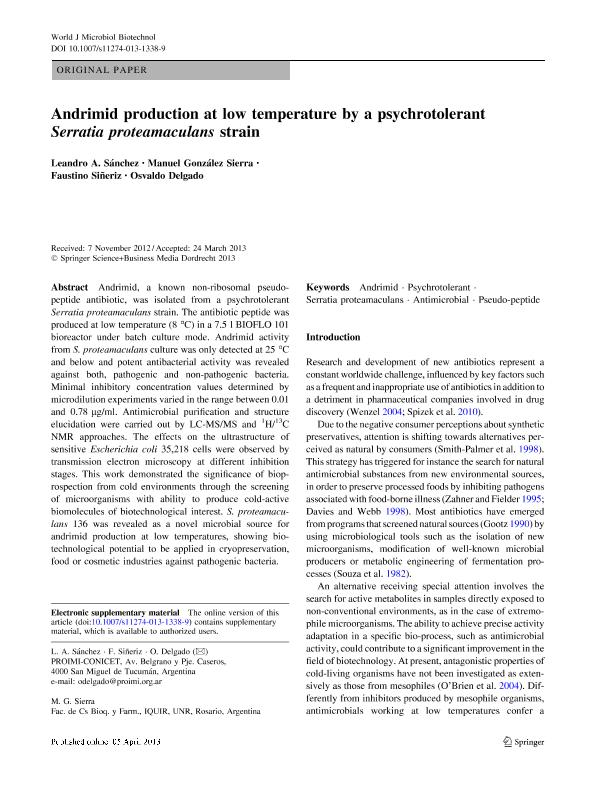Artículo
Andrimid production at low temperature by a psychrotolerant Serratia proteamaculans strain
Fecha de publicación:
04/2013
Editorial:
Springer
Revista:
World Journal of Microbiology
ISSN:
0959-3993
Idioma:
Inglés
Tipo de recurso:
Artículo publicado
Clasificación temática:
Resumen
Andrimid, a known non-ribosomal pseudo- peptide antibiotic, was isolated from a psychrotolerant Serratia proteamaculans strain. The antibiotic peptide was produced at low temperature (8 °C) in a 7.5 l BIOFLO 101 bioreactor under batch culture mode. Andrimid activity from S. proteamaculans culture was only detected at 25 °C and below and potent antibacterial activity was revealed against both, pathogenic and non-pathogenic bacteria. Minimal inhibitory concentration values determined by microdilution experiments varied in the range between 0.01 and 0.78 lg/ml. Antimicrobial purification and structure elucidation were carried out by LC-MS/MS and 1H/13C NMR approaches. The effects on the ultrastructure of sensitive Escherichia coli 35,218 cells were observed by transmission electron microscopy at different inhibition stages. This work demonstrated the significance of biop- rospection from cold environments through the screening of microorganisms with ability to produce cold-active biomolecules of biotechnological interest. S. proteamacu- lans 136 was revealed as a novel microbial source for andrimid production at low temperatures, showing bio- technological potential to be applied in cryopreservation, food or cosmetic industries against pathogenic bacteria.
Archivos asociados
Licencia
Identificadores
Colecciones
Articulos(IQUIR)
Articulos de INST.DE QUIMICA ROSARIO
Articulos de INST.DE QUIMICA ROSARIO
Articulos(PROIMI)
Articulos de PLANTA PILOTO DE PROC.IND.MICROBIOLOGICOS (I)
Articulos de PLANTA PILOTO DE PROC.IND.MICROBIOLOGICOS (I)
Citación
Sanchez, Leandro Arturo; González Sierra, Manuel; Siñeriz, Faustino; Delgado, Osvaldo Daniel; Andrimid production at low temperature by a psychrotolerant Serratia proteamaculans strain; Springer; World Journal of Microbiology; 29; 10; 4-2013; 1773-1781
Compartir
Altmétricas




